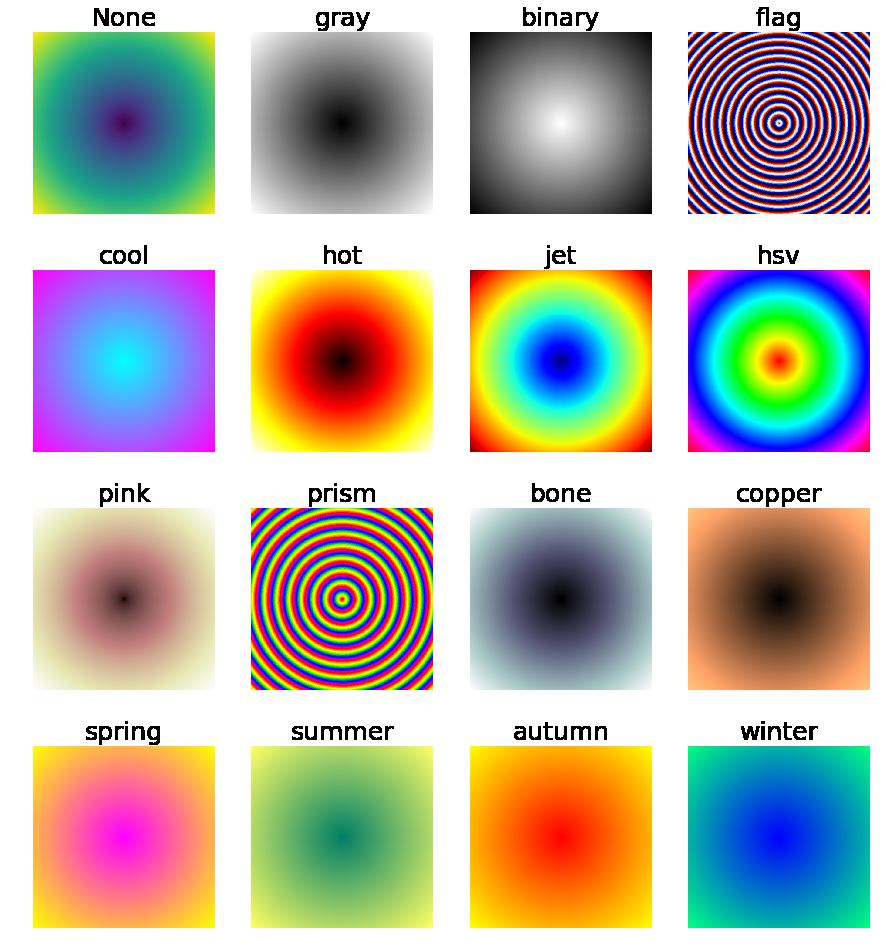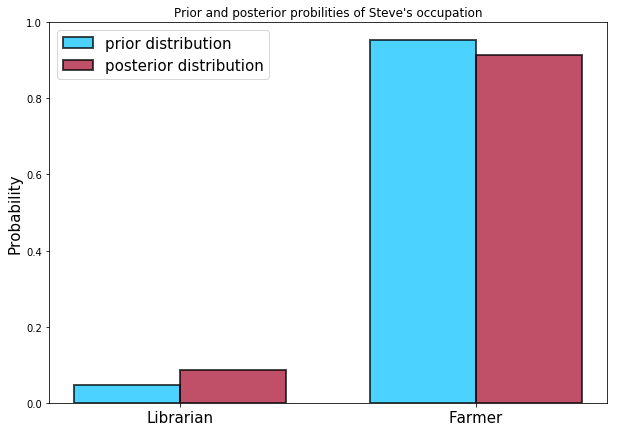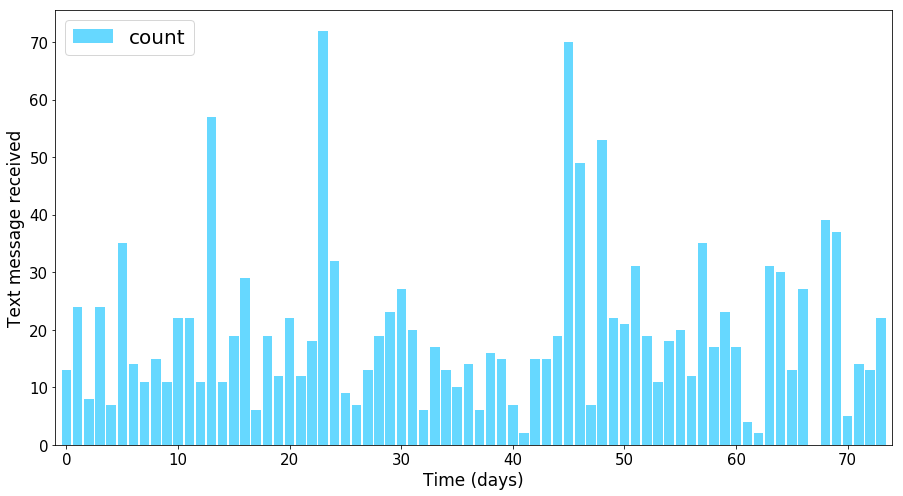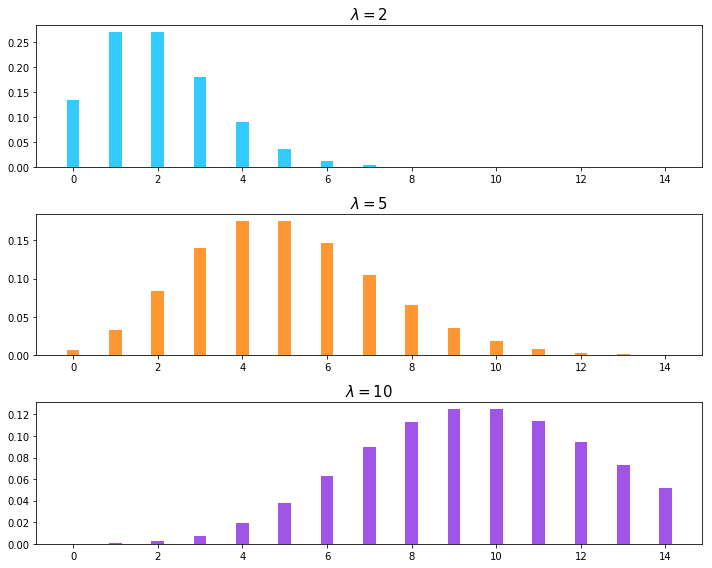 foolish fly fox's blog
foolish fly fox's blog
--Stay hungry, stay foolish.
--Forever young, forever weeping.
数据可视化
数组的显示
cmap 的使用
创建一个的数组:
tp = np.arange(-3, 3, 0.01) x, y = np.meshgrid(tp, tp) digit_a = (x**2+y**2)**.5
对该数组以各种 cmap 进行可视化:
import matplotlib import matplotlib.pyplot as plt def show_array(a, n, cmap=None): plt.subplot(1, 4, n) plt.title(cmap) if cmap : plt.imshow(a, cmap) else : plt.imshow(a) plt.axis('off') plt.figure(figsize=(15, 15)) # 默认情况 show_array(digit_a, 1) # gray 最小值-黑色 最大值-白色 show_array(digit_a, 2, 'gray') # binary 最小值-白色 最大值-黑色 show_array(digit_a, 3, 'binary') # flag 包含红色、白色、绿色和黑色 show_array(digit_a, 4, 'flag') plt.show() plt.figure(figsize=(15,15)) # cool 包含青绿色和品红色的阴影色, 冷色调 show_array(digit_a, 1, 'cool') # hot 从黑色平滑过度到红色、橙色和黄色的背景色,然后到白色,红外成像 show_array(digit_a, 2, 'hot') # jet 从蓝色到红色,中间经过青绿色、黄色和橙色 show_array(digit_a, 3, 'jet') # hsv 从红色,变化到黄色、绿色、青绿色、品红色,返回到红色 show_array(digit_a, 4, 'hsv') plt.show() plt.figure(figsize=(15,15)) # pink 柔和的桃红色 show_array(digit_a, 1, 'pink') # prism 重复这六种颜色:红色、橙色、黄色、绿色、蓝色和紫色 show_array(digit_a, 2, 'prism') # bone 具有较高的蓝色成分的灰度色图 show_array(digit_a, 3, 'bone') # copper 从黑色平滑过渡到亮铜色 show_array(digit_a, 4, 'copper') plt.show() plt.figure(figsize=(15, 15)) # spring 包含品红色和黄色的阴影颜色 show_array(digit_a, 1, 'spring') # summer 包含绿色和黄色的阴影颜色 show_array(digit_a, 2, 'summer') # autumn 从红色平滑变化到橙色,然后到黄色 show_array(digit_a, 3, 'autumn') # winter 包含蓝色和绿色的阴影色 show_array(digit_a, 4, 'winter') plt.show()
效果为:

用 matplotlib 绘图
首先应该说明一下绘图库 seaborn 和 matplotlib 的关系:
Seaborn其实是在matplotlib的基础上进行了更高级的API封装,从而使得作图更加容易,在大多数情况下使用seaborn就能做出很具有吸引力的图,而使用matplotlib就能制作具有更多特色的图。应该把Seaborn视为matplotlib的补充,而不是替代物。
所以,不是说为了图方便直接掌握 seaborn 绘图就好了,很多时候,matplotlib 绘图更加方便灵活。
绘图必须引入的库:
import matplotlib import matplotlib.pyplot as plt
绘制直方图
绘制提供了数据的直方图,可以使用函数 plt.bar
plt.figure(figsize=(10, 7)):指定绘制图的大小;
plt.bar(x, height, width=0.8, bottom=None, hold=None, data=None, **kwargs)x:直方图指定位置条形的中心点对应的 x 位置height:对应位置条形的 y 值weight:对应位置条形的宽度color:颜色,如 “#00bffff” 指定颜色为天蓝色,也可以写为 "deepskyblue"alpha:透明度,0~1 之间label:对应的条形名称,需要调用plt.legend才能显示edgecolor:条形边框颜色lw:也可以记为linewidth,条形边框的宽度
plt.legend(loc="upper left", fontsize=15):指定图示的显示loc:图示显示的位置,有best、upper right、upper left、lower left、lower right、right、center right、center left、lower center、upper center、centerfontsize:图例文字大小
plt.xticks([0.125, 0.825], ['Librarian', "Farmer"], fontsize=15)- 参数1:x 轴记号的位置
- 参数2:记号文本
fontsize:字体大小
plt.title("figure title"):设置图片标题
plt.ylabel('probability', fontsize=15):设置 y 轴含义
plt.show(): 显示图片
import matplotlib import matplotlib.pyplot as plt colors = ["deepskyblue", "#A60628"] prior = [1/21.0, 20/21.0] plt.figure(figsize=(10,7)) plt.bar([0., 0.7], prior, width=0.25, alpha=0.7, color=colors[0], label="prior distribution", lw="2",edgecolor="#000000") posterior = [0.087, 1-0.087] plt.bar([0.+0.25, 0.7+0.25], posterior, width=0.25, alpha=.7, color=colors[1], label="posterior distribution", lw="2", edgecolor="black") plt.legend(loc="best", fontsize=15) plt.xticks([0.125, 0.825], ['Librarian', "Farmer"], fontsize=15) plt.title("Prior and posterior probilities of Steve's occupation") plt.ylabel("Probability", fontsize=15) plt.show()
显示为:

另一个例子:
import pandas as pd import seaborn as sns data = np.array(( [ 13., 24., 8., 24., 7., 35., 14., 11., 15., 11., 22., 22., 11., 57., 11., 19., 29., 6., 19., 12., 22., 12., 18., 72., 32., 9., 7., 13., 19., 23., 27., 20., 6., 17., 13., 10., 14., 6., 16., 15., 7., 2., 15., 15., 19., 70., 49., 7., 53., 22., 21., 31., 19., 11., 18., 20., 12., 35., 17., 23., 17., 4., 2., 31., 30., 13., 27., 0., 39., 37., 5., 14., 13., 22.])) x = range(len(data)) plt.figure(figsize=(15,8)) plt.bar(x, data, width=0.85, color="#00bfff", alpha=0.6, label="count") plt.legend(loc="upper left", fontsize=20) plt.xticks(fontsize=15) plt.ylabel("Text message received", fontsize=17) plt.xlabel("Time (days)", fontsize=17) plt.yticks(fontsize=15) plt.xlim(-1, len(x)) plt.show()
对应图形为:

下面再来绘制泊松分布:
import numpy as np import scipy def poisson(lamd, k): return lamd**(k)*np.exp(-lamd)/scipy.misc.factorial(k) k = np.arange(15) lamds = [2, 5, 10] colors = ['#00bfff', "#ff7f00", "#8a2be2"] linew = 0.3 plt.figure(figsize=(10, 8)) for i in range(len(lamds)): lamd = lamds[i] plt.subplot(len(lamds),1,i+1) plt.title(f"$\lambda = {lamd}$", fontsize=15) plt.bar(k, poisson(lamd,k), color=colors[i], alpha=0.8, width=linew) plt.tight_layout() plt.show()
其中函数 plt.tight_layout 避免图标题和上一幅图的指标标记重叠,绘制的图像为:

泊松分布的期望是:。